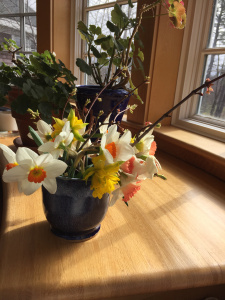Leaving Out Lines
Writing poetry means not only coming up with words, but then eyeing them with ferocity, challenging them to show their worth. I cross out words and stanzas from those I’ve already honed as I try to figure out how much I can get across in one small space.
Which means that when I read poems, I’m sometimes struck by words I think should have been left behind. The woman who writes with scissors doesn’t entirely leave them when she reads. I’m reacting to having just read some poems that were inspired by a line or the structure of well-regarded poems, which was acknowledged with footnotes. It’s fine to begin a poem this way. It’s fine to begin anywhere. But I found these footnotes got in my way, and the echoed architecture distracted more than deepened. I’m a fan of Sharon Creech’s Love That Dog, in which the title and arc pay homage to Walter Dean Myer’s poem, “Love That Boy.” In the book, the teacher has students read poems by William Carlos Williams, Robert Frost, and others and use their forms as inspiration. That works well within a classroom, but at some point, particularly before publication, I’d prefer to have those spurs to inspiration erased.
I’ve started poems and novels from scenes that get deleted. Sometimes that same scene has started other projects. Just because it inspires, doesn’t mean it should stay. The original line or image might be left out perhaps as often as I cut the last summing up words of a poem or chapter. We need any kind of inspiration to begin, and we need a point to the story, but what happens in between should show what we meant to show without a small marquee drawing attention to the message. The trick we keep learning is how to give just enough detail to ignite a reader’s imagination, and then step back and let them enter and claim the story.
I recently heard poet Mary Rueffle, author of the wonderful Madness, Rack, and Honey: Collected Lectures, answer a question asked how she went about editing her poems. She replied, “When it’s a really bad line I draw a line through it, then put the parts that love each other closer together.” And she explained that the love is about language, the sound, meaning, and connotation of words. Sometimes I ask poetry students to try cutting their poems in half. If that feels too painful, I give the option of expanding them to twice their length, but dividing the poem can produce something dense and precious as knitting.






